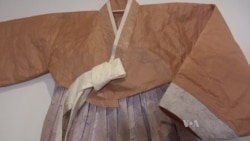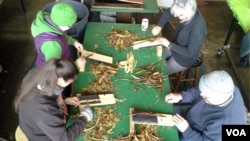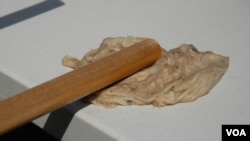Once renowned in Asia for its durability and versatility, traditional Korean paper called Hanji is now produced only in a handful of rural paper mills.
But Korean-American artist Aimee Lee is dedicated to carrying on the 2,000-year old tradition through her artwork and teaching. And some of the artwork she produces from the famously durable paper are wearable.
“The very first dress that I made out of Hanji was a western dress, but, as I was making more dresses, I thought just in the way that I explored Korean paper… I thought it would be wonderful to explore Korean dresses.”
The dress and other artwork by Lee created with Hanji, traditional Korean paper, are on display in a group exhibition during May at the Korean Cultural Center in Washington to mark Asian American and Pacific Islander Heritage month.
"Delicacy and strength is what I found in Korean paper,” says Jeanne Drewes, chief of binding and collections care at the Library of Congress. To Drewes, what the exhibit shows is that paper and fabric can be almost interchangeable. “That comes out in this exhibit. This exhibit is so wonderful."
Born in New York, Lee’s dedication to Hanji started in 2008 when she went to Korea with a U.S. Fulbright grant to research the disappearing traditional paper arts. She apprenticed at a papermill in a remote village. It was run by a fourth-generation family whose patriarch is the Korean National Intangible Cultural Property holder of Hanji making. National intangible property is traditional knowledge that the South Korean government has designated for preservation. And intangible cultural property holders are masters of their crafts.
Lee turned what she learned about paper-making in Korea into a video which can be viewed here.
US Hanji studio
“When I first came back from Korea, I was so, so committed to sharing everything that I learned because it was so compelling, so interesting,” Lee says. “What I like about Hanji is that it’s so versatile. So you can do so many things. I thought the world really needed to know."
Working with the Morgan Conservatory, a non-profit arts center in Cleveland, Ohio, Lee built the first U.S. Hanji studio in 2010 to make and share the craft of Korean papermaking. Each fall, mulberry trees whose inner bark is used to make Hanji, are harvested from the conservatory’s garden.
"I gather raw plant material from outside and then have to go through the process of stripping, sorting the parts you need and cooking it in special solutions and rinsing it, beating it and then making paper. And then making art from that. So it is a whole range from scratch.”
The self-appointed Hanji ambassador lectures or teaches workshops at art museums and universities across the country. Lee's passion for the paper led to her award-winning book: Hanji Unfurled: One Journey into Korean Papermaking.
“Actually more people not of Korean descent take my workshops than people of Korean descent. I think people that come are very open-minded. It is a way to learn about other cultures in a way that is very hands-on.”
Lee also uses natural dyes she makes from kitchen scraps and flowers. Her artwork ranges from traditional objects to more contemporary woven paper objects. Her series of artists books reside in library collections including Yale University library.
Lee plans to continue making Hanji indefinitely. She says, “I still feel like there are so much I can do and learn.”











